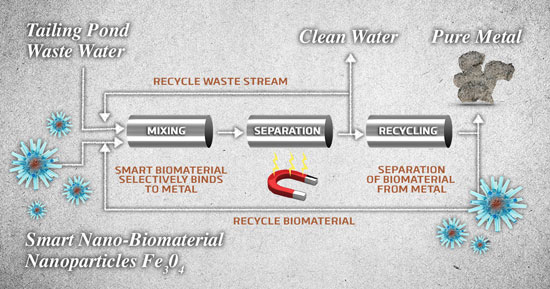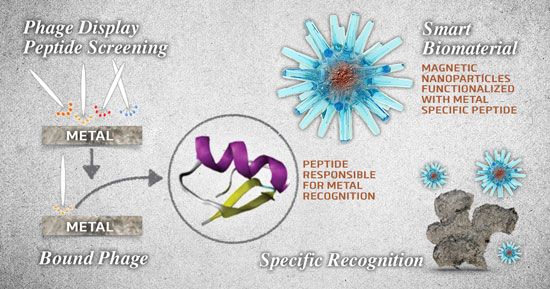| Posted: Feb 03, 2014 | |
Ingenuity attracts attention with biomining advances |
|
| (Nanowerk Spotlight) Scientists at Ingenuity Lab in Edmonton, Alberta are taking cues from nature, as they focus on nanotechnology gains in the area of biomining. Using microorganisms and biomolecules, the group is making significant advances in the recovery of rare earth and precious metals from industrial processes and the environment thanks to superior molecular recognition techniques. | |
| In recent decades, the utility of protein/peptide molecules and their inorganic material recognition and binding abilities has come to light. Combinatorial biology tools have enabled researchers to select peptides for various materials such as ceramics, metal oxides, alloys and pure metals. Even though the binding mechanism of peptides hasn’t yet been fully resolved, studies are ongoing and these peptides continue to be used in many nanotechnology applications. | |
| Peptides affectivity on control over the morphology during material synthesis has led to their use in nanoparticle production. And due to their self-assembly ability, application to surface coatings has been shown to increase biocompatibility and/or antimicrobial properties. Similarly and mainly because of their ease of modification and conjugation with other bio- and synthetic- molecules, peptides have also been used for assembly of nanoscale objects and development of sensing platforms. As such, researchers at Alberta’s first nanotechnology accelerator laboratory are looking to take advantage of inorganic binding peptides for mining valuable and rare earth elements/metals that exist in nature or synthetic materials. | |
 |
|
| (click image to enlarge) | |
| Rare earth elements (REE) are sought after materials that facilitate the production of electrical car batteries, high power magnets, lasers, fiber optic technology, MRI contrast agents, fluorescent lightening and much more. Despite increasing demand, mining and processing yields are not enough to satisfy the growing need. This is mainly due to the great loss during mining (25-50%) and beneficiation (10-30%). | |
| Since REEs exist as a mixture in mineral ores, their beneficiation and separation into individual metals requires unique processes. Depending on the chemical form of the metal, different compounds are necessary during beneficiation steps to convert minerals into metal nitrates, oxides, chlorides and fluorides, which would be further extracted individually. Furthermore, this process must be followed with solvent separation to obtain individual metals. These excessive steps not only increase the production cost and energy consumption but also decrease the yield and generate environmental pollution due to the use of various chemicals and organic solvents. | |
| Specific/targeted separation methods hold the most promise in terms of increased purification yields and decreased cost. In the case of REE separations, utilization of peptides with specific binding affinities to different REE could provide the ultimate solution. Ingenuity Lab is working on generating smart biomaterials composed of inorganic binding peptides coated on the core of magnetic nanoparticles. These smart materials will expose two functions; first they will recognize and bind to a specific REE through the peptide region and they will migrate to magnetic field by the help of Iron Oxide core. This will allow the smart material to purify an individual metal from a mixture without excessive solvent extraction, filtration and concentration steps. | |
 |
|
| (click image to enlarge) | |
| As shown in the illustration Figure, Ingenuity’s system will also be able to work in a continuous flow process. There will be a constant input of metal mixture, which could be mine acid drain, tailing ponds or polluted water sources, and smart biomaterial. Biomaterial will be recovered from the end point of the chamber together with the targeted metal. Since the interaction between the peptide and the metal of interest is not covalent bonding, metal will be removed from the material without the need for harsh chemicals. This means valuable materials, currently discarded as waste, will be accessible and the reuse of the smart biomaterial will be an option, lowering the purification cost even more. | |
| These exciting discoveries are welcome news for the mining industry and the environment, but also for communities around the world and generations to come. Thanks to ingenuity, we will soon be able to maximize the utility of our precious resources as we restore damaged lands and water. | |
|
Source: Ingenuity Lab
|
|
|
Become a Spotlight guest author! Join our large and growing group of guest contributors. Have you just published a scientific paper or have other exciting developments to share with the nanotechnology community? Here is how to publish on nanowerk.com. |
|
